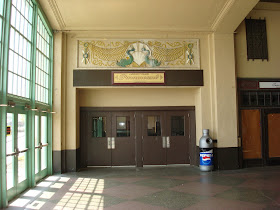My friend Neal sent me this:
Weird rituals greet start of summer season in NJBy WAYNE PARRY, Associated Press Writer Wayne Parry, Associated Press Writer - Wed May 20, 5:47 pm ET
OCEAN CITY, N.J. - Merchants in suits and dresses will parade into the sea in Ocean City, Atlantic City will "unlock" the ocean, and the beer will flow bright and early in Point Pleasant Beach.
It's all part of the kickoff of summer at the Jersey Shore. The recession is expected to slow travel and tourism somewhat, but tourism remains New Jersey's second-largest industry, and this weekend it kicks into high gear.
The number of drivers taking to the roads this weekend is projected to be down slightly as the recession keeps some folks close to home. About 7.4 million drivers are expected to use the Garden State Parkway between Thursday and next Tuesday, down from 7.6 million last year, according to the New Jersey Turnpike Authority.
"Financial uncertainty is what's keeping more people from traveling," said David Weinstein, a spokesman for AAA Mid-Atlantic. "Even so, gas prices remain well below last year's."
The average cost for a gallon of regular gasoline is expected to be $2.20 this weekend, down from $3.81 last year.
"The high-water mark should be no more than $2.50 per gallon this summer nationally and the Jersey gallon is typically 10 to 15 cents cheaper than the national average," Weinstein said. "These prices continue to be a silver lining."
That should make it cheaper to get to Ocean City, the southern New Jersey resort that was named the state's best beach this week. On Friday, Ocean City merchants will don their best business attire, clutch briefcases, and march into the ocean to the strains of "Pomp And Circumstance," something the city does each year to kick off summer. No one is really sure why.
On Sunday in Atlantic City, Mayor Lorenzo Langford and Miss Atlantic City will symbolically "unlock" the ocean, though no one locks it back up again in October.
And in Point Pleasant Beach, the Friday of Memorial Day weekend is traditionally high school cut day, when plenty of youngsters - not to mention their parents - turn out early for a free concert at a boardwalk bar that spills onto the sand. This year's show features Rascal Flatts.
A major overhaul of the Parkway's Driscoll Bridge is finished just in time for the summer crowds. The $225 million project has given it greater capacity than the George Washington Bridge.
The bridge, over the Raritan River, expanded from 12 lanes to 15 and added shoulders. The lack of shoulders had aggravated congestion during breakdowns and accidents.
Air travel at Newark Liberty International Airport is expected to be down 6.1 percent this weekend, with more than 448,000 passengers arriving or departing.





















































 The Boss wrote "
The Boss wrote "